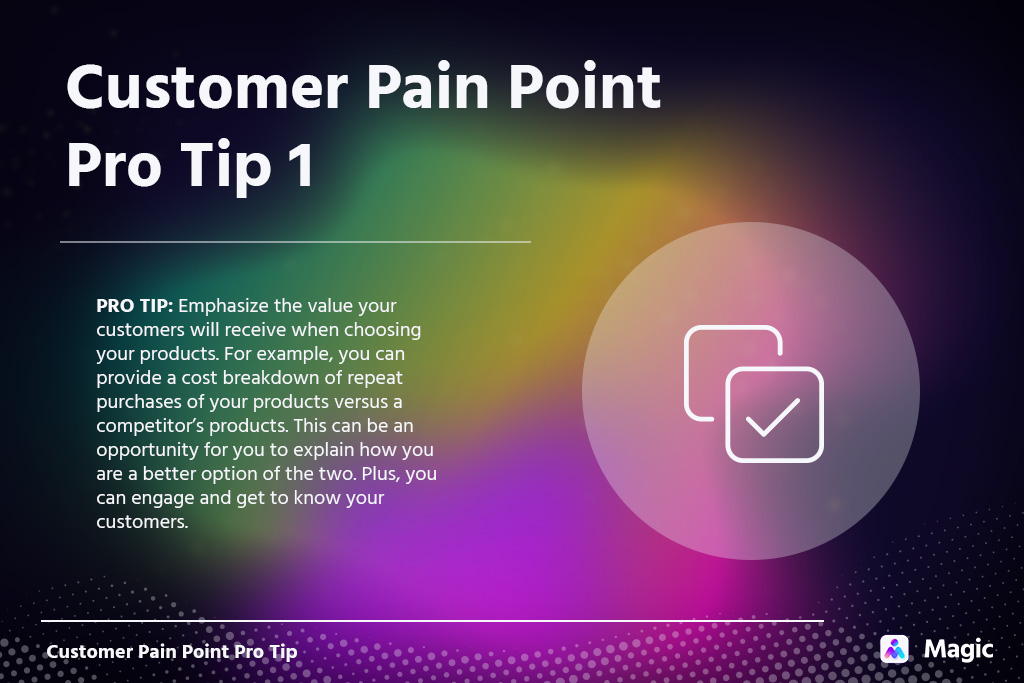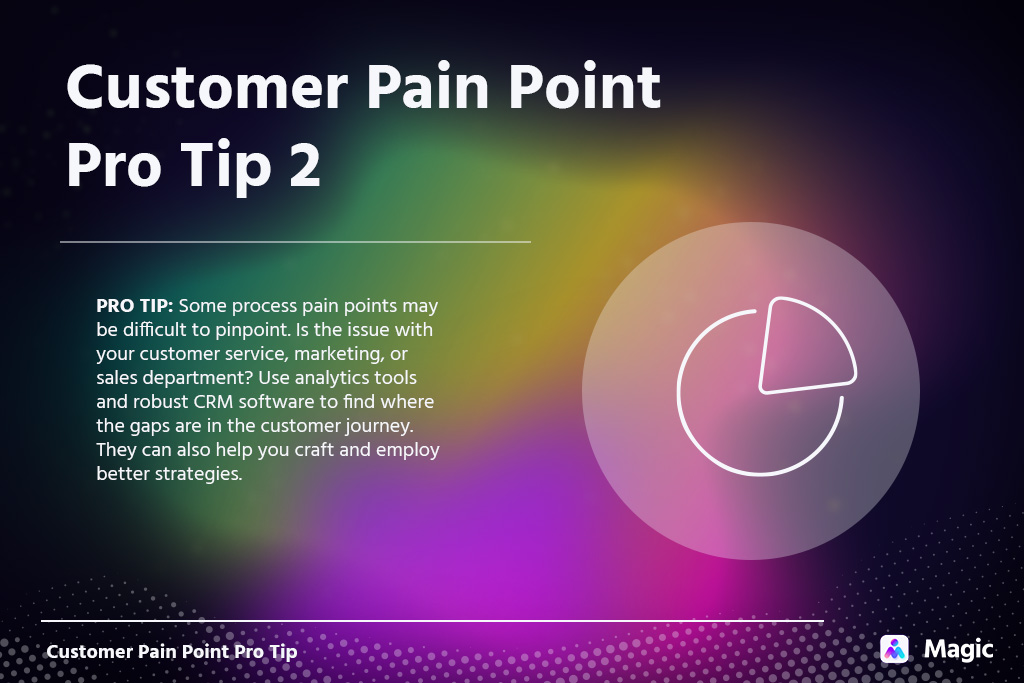Of all the potential customers who convert into leads, only around 10-15% go on to actually make a purchase. Many issues in the customer journey can cause someone to decide against buying. This may be the cost, convenience, or points of contact, among others.
If you know how to identify customer pain points, you’ll be able to address them adequately. This way, you won’t just turn more leads into buyers but also your competition’s would-be clients!
What Is a Customer Pain Point?
Customer journey pain points are specific problems that buyers or prospects have with a product or service. They can also be unmet needs waiting to be fulfilled along their customer journey.
Understanding customer pain points is crucial to a business when they are trying to come up with a proper value proposition. This, in turn, impacts both your sales and marketing strategies. It also allows you to enhance the experience of different types of customers.
Types of Customer Pain Points
Before you learn how to identify customer pain points, you need to be aware of how they are classified. This makes it easier to know where you need to start looking. It also allows for a more streamlined process of creating and employing a framework to deal with it.
There are four main types of customer pain points:
1. Process Pain Points
Process pain points are issues in the internal processes through which a business interacts with prospects. These refer to cases in which it takes too long to get a response, causing people to lose interest.
Customer pain points examples:
- Problems in sending an application
- Too many pages to go through on the website
- Waiting time in connecting to the right department is too long
- Weak communication between teams
2. Financial Pain Points
Financial pain points come from the buyers’ desire to reduce the money they’re spending on a product. It can also be the financial strain of using a product over time.
Customer pain points examples:
- Hidden or extra fees at checkout
- Costly subscription plan or membership fee
- High cost of items that are often purchased frequently
- Product has a shorter life span than its marketed longevity
3. Support Pain Points
Support pain points arise from a business’ failure to help people with their queries throughout their customer journey. Simply put, they concern the customer support services of your business.
Customer pain points examples:
- Limited active hours for help desk or call center
- Delayed response to a customer support ticket
- Lack of product knowledge of sales rep
- Customer’s preferred support channel is not available
4. Productivity Pain Points
Productivity pain points are caused by the buyer’s unmet need for a better experience in using a product. This means that buyers want to maximize the efficiency of their purchase or have a streamlined buying process.
Customer pain points examples:
- Lack of automation
- Redundancies or friction in a certain process
- Inconvenience in using the acquired product
- Complex checkout method
Identifying Customer Journey Pain Points
Many prospects are likely to experience the same customer journey pain points. Looking into your customer experience can help you pinpoint pain points. Once you find the pain point, you should dig deeper for the root of the problem to solve it properly.
How to identify customer pain points:
1. Conduct research and surveys
A great way to pinpoint target audience pain points is by conducting studies to get customer feedback in detail. You can use methods such as:
- Qualitative market research – yields in-depth, individualized answers from customers by asking open-ended questions about their experiences. This method is preferred in pinpointing business problems since customer pain points are highly subjective.
- Quantitative market research – yields data from buyers by asking questions, usually answered by yes or no or a 1-10 scoring system. It’s an easier way to get customer data, especially for topics with gray areas. That said, it can be too restrictive to find detailed pain points.
- Online surveys – yield specific data from current and prospective customers by asking targeted questions through online platforms. They cost less and are easy to use but have strong response rates. You can use platforms such as Google Forms, SurveyMonkey, or WPForms survey add-on.
Keep in mind that asking the right questions will give you answers and insights from your clients. Make sure that you keep them simple enough. This will encourage people to submit their responses, especially those who dislike filling out forms.
2. Practice social listening
Whether you can close a deal or not is really up to your customers. This means you should always be open to what they have to say. You have to understand where they’re coming from to relate your business to them better.
Social listening is the process of tracking and analyzing customer feedback to find areas of improvement. It can include any direct mentions of your brand or discussions about relevant topics on social media.
This is a useful tactic to enhance your customer experience. It even strengthens your brand identity and personality. Listening to your customers shows people that you do care about them.
Since you get access to your audience’s sentiments, experiences, and expectations, you can find pain points easily. Collecting feedback and online resources like industry benchmarks and relevant studies also allows you to identify patterns and trends.
This lets you better understand the cause of any pain point you find. With it, you can tailor your business to meet their needs and create content relevant to their interests.
3. Check in with your sales, marketing, and support teams
The teams in your business should work with each other to gain a holistic understanding of customer pain points.
Keeping in touch with the sales, marketing, and support teams can help properly classify customer journey pain points. It can also help you decide which team is most suitable to address them.
Aligning sales and marketing data can create a unified approach to pinpoint common pain points. On the other hand, the support team can facilitate different methods of collecting customer feedback.
For instance, your support team can set up a live chat feature for your customers. It’s a great way to quickly pinpoint customer demands and issues, as well as offer timely solutions.
The sales team can then address these pain points head-on while reinforcing why your product or service can solve these. Next, the marketing team can expound on the solution by posting useful and engaging content related to it.
Addressing Customer Pain Points
The main point of learning how to identify customer pain points is to effectively solve them. This way, customers are more inclined to buy from your business than other competitors.
Focus on common pain points
In the course of finding customer pain points, you’ll come across issues shared by many customers. Some of the most common examples of customer pain points include:
- Complex checkout processes
- Delayed support response
- Rude customer service reps
Starting with these pain points allows you to improve your customer experience at a low cost and effort. For example, you can research what customers perceive as offensive and draft a customer support dialogue using positive scripting. You can also train your CSRs to handle tricky situations using escalation management.
Resolving common pain points first also allows you to provide a more personalized customer journey. With minor issues resolved, you have more time to focus on more specific and pressing problems.
Provide omnichannel communication
The earlier you find customer journey pain points, the faster you can provide a solution. Omnichannel communication, which uses many platforms like social media and web pages, makes it easier for customers to reach you.
Automate internal processes to improve productivity and reduce costs. A unified dashboard can give you a complete view of customer data. This can help your sales, marketing, and support teams to collaborate better. In turn, your business can provide a consistent and customized experience across various touch points.
Educate customers on your solution
Of course, addressing customer pain points without conveying how you’re going to solve them won’t lead to a sale. So, you have to show your customers that you understand their problems and you want to help solve them.
To do so, use the same language your prospects use when talking about their pain points. This psychological technique makes the conversation feel more genuine and human which shows that you take them seriously.
You can use your knowledge about customer journey pain points by tailoring your solution to their needs. This can be done in many ways including:
- Making your sales pitch more personable
- Offering product training and guides
- Highlighting the strengths of your product in making their lives easier
- Posting blog content with topics relevant to their pain points
Social proof can also provide hands-on accounts of how your product solves your target audience pain points. This includes different case studies, reviews, and feedback from other customers.
Solve Customer Pain Points With Magic
With Magic services, take on customer journey pain points with more ease. Magic has a roster of vetted assistants that specialize in customer support, customer relationship management (CRM), sales, and more.
Here’s how we can help with different types of customer pain points:
Magic Services for Financial Pain Points
This type of pain point revolves around customers having to spend an excessive amount of money. However, lowering your prices is not always the best solution. There may be times when you need to retain your current price point to sustain a good profit margin.
With no strategic pricing, you might end up selling your products for a lower profit.
For instance, Candela, a medical aesthetic device firm, turned to a subscription model for its UltraShape Power system. This allowed them to attract more customers and understand them better.
By shifting to subscriptions, they gained more insight into how many pulses their customers need for a certain period of time. They then used this data to offer packages and monthly consumption plans that catered to their customers.
What Magic Can Do:
- Assist in implementing campaigns for product launches
- Manage social media accounts to increase engagement and traffic
- Run paid ads on Google, LinkedIn, Facebook, Instagram, etc.
Magic Services for Process Pain Points
Customers need to have a consistent experience across every channel and interaction they have with your business. This can take place on your website, on social media, and in person. Tackling these pain points will help streamline the purchasing process.
Take Canopy as an example, an insurance agency that used legacy solutions and spreadsheets to manage its customer data.
As they grew and the volume of clients increased, they realized they needed to use a real-time CRM solution. With Zendesk Sell, they gained a better outlook on their customer data through its built-in analytics tools.
What Magic Can Do:
- Enter data in your CRM database and create reports using the data
- Compile customer data from various sources to keep your database updated
- Use integration tools such as Slack and Salesforce to ensure a streamlined customer experience
Magic Services for Productivity Pain Points
Like process pain points, this also involves the purchasing process. It puts a focus on the comfort and efficiency a product can or can’t give to a client.
With Kontakt.io, they require a support team that can quickly tend to their customers’ concerns regarding their Bluetooth devices. To do that, their sales and support teams must be able to collaborate with each other seamlessly.
So, Kontakt used an integration tool to provide visibility and access to customer data for both teams. This, in turn, allowed them to solve their buyers’ concerns more efficiently. This resulted in an 18% increase in support request capacity.
What Magic Can Do:
- Use tools to automate work such as updating your online store inventory and email responses.
- Manage emails, files, and other records needed for processes
- Handle appointment scheduling
- Track shipping and delivery
Magic Services for Support Pain Points
The slightest hiccup can turn a customer away for good. Based on an American Express study, 33% of clients say they would switch providers after one poor customer experience.
Truffle Shuffle approached Magic to address this pain point. Customer support assistants made sure that their customers were tended to in each class. They answered the questions sent in the chat box while the chef and other employees involved had their hands full.
What Magic Can Do:
- Engage in real-time conversations with prospects to answer their queries and assist them in their purchase
- Track engagement from buyers such as comments, likes and dislikes, and feedback
- Process payments, refunds, and other requests
Knowing how to identify customer pain points and resolve them will make you stand out in the market. While there are many common pain points, there’s no “one size fits all” approach to tackle them. It’s crucial to get to the root of the problem and deliver a personalized solution.
Magic provides a hassle-free process to delegate business tasks to remote workers so you can focus on what matters most. A Magic Virtual Assistant will help pinpoint and act on your pain points for better chances of closing more sales.
Book a call now to get started!












